Katy Pyle’s Ballez performs Sleeping Beauty and the Beast in the La MaMa Moves Festival.
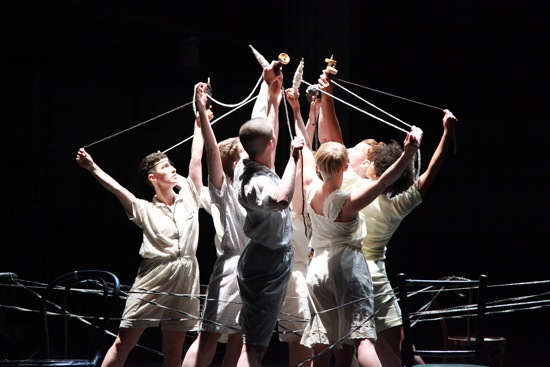
Act 1 Prologue of Sleeping Beauty and the Beast. In no particular order: iele paloumpis, Lindsay Reuter, Ashley Yergens, Erica Ricketts, Eliana Dell’Anna, Kirstin Dahmer, Khadijah Griffith, Janet Werther. Photo: Theo Cote
This is, I promise, the last time I will blame acute jet lag for my sense of disembodiment and lapses in understanding. It kicks in the moment I go to the La MaMa box office, and there seem to be no tickets in my name for Katy Pyle’s Sleeping Beauty and the Beast. Once in the theater, I don’t read the program carefully, so I’m confused as to the identity of the nine performers who arrive on the scene tying on white aprons and head coverings. When the French horn player appears late and slips unobtrusively into his place among the Queer Urban Orchestra members already attacking the Tchaikovsky music, I wonder if this could be a staged moment. To add to my unbalanced state, we are told to go downstairs for the intermission and the second act, and I eventually find myself in a large basement theater I’VE NEVER SEEN BEFORE. Later I can’t remember how I got there.
Enough! Pyle’s gloss on the famed 19th-century Russian ballet and performed by the Ballez Company is excellently thought out, although, yes, it’s too bad that you need to read a lot of program material before it starts. Pyle has renovated the story’s heroine, Aurora, as a girl who approaches her sixteenth birthday with gender-anxiety. She’s no princess but the daughter of a wealthy Lower East Side factory owner. Those people tying on aprons are factory workers, and, in the words of the program, a “lesbian identified fibre artist” (Jules Skloot, who also provided some of the choreography) is rallying them to strike (cue the raised fists).
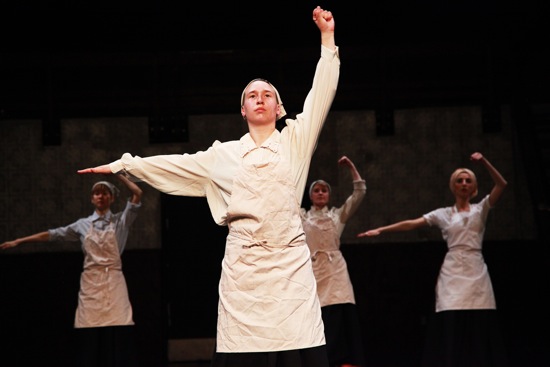
The garment factory workers unite. Erica Ricketts (foreground) and (L to R): Mei Yamanaka, Kirstin Dahmer, and Eliana Dell’Anna. Photo: Theo Cote
The same performers also provide the opening sequence in which, as magical weavers, they construct the tale. Holding long strands attached to a base on the floor and stepping over and ducking under the strings as they dance, they don’t end with a clear design, as with a maypole, but their patterned actions are themselves ingenious (if slightly over-long). They, according to the program, are weaving the fabric of the story, but the scene also reminds us that a spindle was the crucial ingredient in the fairy Carabosse’s retaliation for not being sent an invitation to Aurora’s christening. Glamorously snarky, Deborah Lohse plays the wicked interloper as an “outcast dyke cousin,” who predicts what is about to unfold.
The three fairies (sorry: faeries) who were invited to the party arrive wearing 18th-century male attire. Both the Scarlet Faerie (Charles Gowin) and the Azure Faerie (Chris Braz) dance the nicely made revised solo variations with aplomb, as does the Lilac Faerie (Chris De Vita). I’m so grateful for the live music that I forgive the occasional sour notes from the orchestra that Julie Desbordes is conducting. The heroine (Madison Krekel) makes her 16th-birthday appearance in a poufy pink gown with her curly black hair flying; bounding around the space, she’s so determined to be adorably feminine you could shake her. But the Lilac Faerie has a rather unusual birthday gift in mind: a lesson aimed at bringing Aurora’s hidden sexual preference into the light of day.
At his urging, she takes off her dress and dons his coat, while he puts on her fluffy petticoat. She’s a bit uncertain about this, but tackles the ensuing pas de deux bravely when the orchestra strikes up Tchaikovsky’s music (arranged by Nick Johnson and Bjorn Berkhout) for the “Rose Adagio.” It’s a touching sight. Small, sturdy Krekel supports the very dignified, tall, long-legged De Vita in various balances and turns. The program synopsis that I didn’t read at the time tells me that he was preparing her to dance with the Union Organizer (thus challenging the barrier between workers and the boss’s daughter, as well as between her urges and her designated gender role).
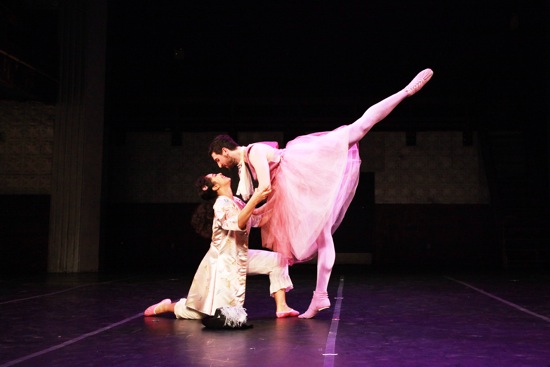
The Lilac Faery (Chris De Vita) gives Aurora (Madison Krekel) a lesson in partnering. Photo: Theo Cote
The birthday party coincides with the workers’ planned protest, but first they waltz with the court (such as it is). To make matters muddy, the printed plot has Aurora’s father, furious to find her dancing with the union guys, trying to force her to leave with him or else. On the other hand, the program also notifies us that “All the straight characters in this story will not be seen onstage, they are made invisible.” (So it’s not just jet lag that’s messing with my brain.) Aurora can’t make up her mind, and we see her distress. In the melée, the Lilac Faerie begins to cast her spell, Aurora accidentally pricks her/his finger on the spindle that the Union Organizer holds out symbolically and falls asleep while he/she kneels beside her in grief before joining all the others who are keeling over to lie there for a hundred years.
This first act that Pyle has designed is like some rich, unusual stew in which a carrot could well be disguised as a chunk of beef and the spices drift together and apart and you can hardly decide what you like best about it and what sticks in your craw. Pyle clearly loves the historical ballet with its happy-ending story, but her mission is to re-mold it to be the armature for political, psychological, and social comment. Aurora may not wake up as your usual blushing bride, but she’ll be a self-confident lesbian. And if it took a fairy tale to accomplish that, so be it.
It was supposedly 1893 when Act 1 ended, and it’s 1993 when the audience enters the basement theater to find the performers lying on the stage in the same positions into which they collapsed a hundred fictional years ago. Except that some helpful magic has updated their clothing while they slept. Now the setting is a nightclub, with the orchestra reduced to Stephanie Babirak on harp and Berkhout on cello, assisted at times by recorded music. Skloot, now designated as the Beast, kisses Krekel awake, and in this, her coming-out party, they observe or join in the dance-and-sex antics hosted by Lohse.
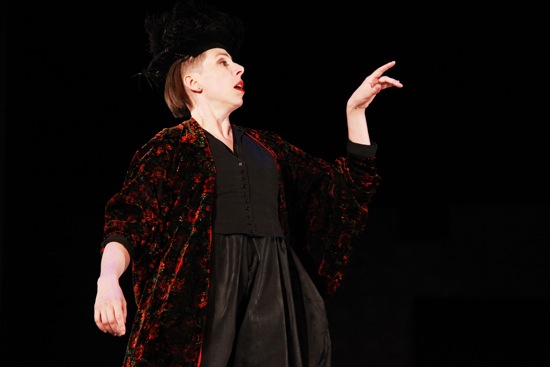
Deborah Lohse, hatted and gowned, as Carabosse in Sleeping Beauty and the Beast. Photo: Theo Cote
Why the Beast? Is it because he functions for a while as death’s helper? Not exactly. Think back to 1993; perhaps those of us who were adults then need to be reminded of the AIDs epidemic, so we can help make sure that those born around that time are aware of its impact.
Enter the “entertainment:” nine performers of various sizes and shapes, dressed in white jockey shorts and wings, join the three former faeries, now similarly dressed. Rippling their arms, bourréeing with their feet, turning in unison, they are now swans—dying swans—and the music being played is by Camille Saint-Saens.
As the dance progresses, they fall to the floor, one by one, and are helped up by Skloot and supported as they stumble out a far door. This is the climax of Sleeping Beauty and the Beast, and I’m sure I’m not the only spectator to feel the prickle of incipient tears. Yes, that’s how we lost them—one, then another, then another.
But Pyle has engineered this Act 2 scene of dying to happen amidst festivities. Again, had I not been too dazed to consult the program during intermission, I would have realized that the weavers cum union workers were now paired as the fairytale characters who appear in the last act of Petipa’s ballet: the Bluebirds, Little Red Riding Hood and the Wolf, etc. Lohse pairs up with Khadijah Griffith, who’s being Cinderella. For some reason, not even the program note makes understandable, Krekel and Skloott try out a little S-M to see if it suits them. Now and then, one of the brief duets is featured, but without the name-tags Pyle has attached to them, I see only different relationships—tough, tender, flirtatious, vicious, tentative. And amid passages in which everyone is dancing, movements that reference those in Act 1 intriguingly surface and disappear.
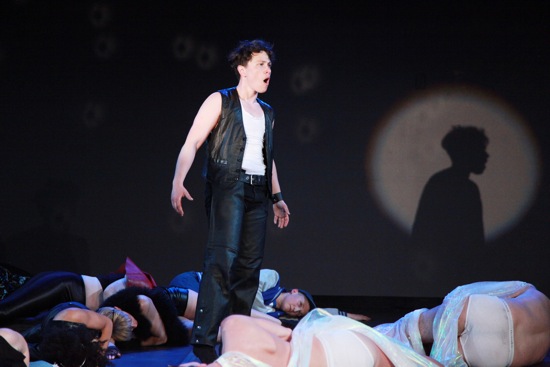
Jules Skloot sings among the fallen. Photo: Theo Cote
De Vita as the Lilac Faerie (also principal swan) dies too, and in silence, his body is borne around the room by the mourners. However, after being laid out, he arises from those clustering around him, now equipped with fan-pleated, clear plastic wings. Gowin and Braz return similarly accoutered, and all join in a dance whose symmetrical tableaux hint at St. Petersburg grandeur and whose circles bespeak a common cause. It is also during this post-funeral scene that Skloot lip-synchs Roy Orbison singing Crying. As Pyle herself queries in the program scenario, this bit may be either too much or not enough.
It’s hugely ambitious for a choreographer to use wit, irony, and flamboyance to deal with gender orientation and an epidemic so unexpected and so horrifying that, in retrospect, it seems almost unreal. An optimistic beginning and a grim (and perhaps Grimm) turn of events resolves in a hopeful finale with an enigmatic final exit of the cast. I won’t dwell on the glitches, tacky patches, incomprehensible bits, or moments that don’t quite crystallize in Sleeping Beauty and the Beast. I salute Pyle and her versatile, committed, up-for-anything cast.
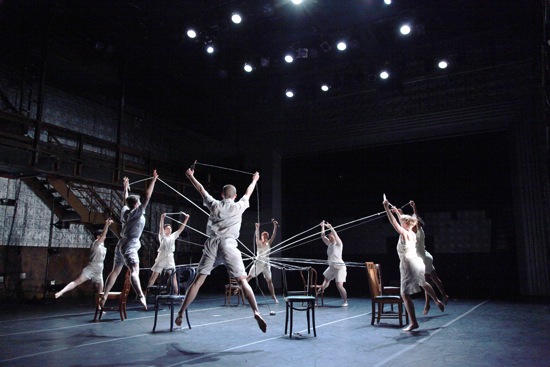
Weavers of the plot in Ballez’s Sleeping Beauty and the Beast keep the circle spinning. Photo: Theo Cote
